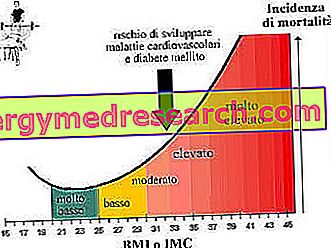Dysentery
Dysentery is an inflammation of the intestine that causes diarrhea mixed with mucus and blood. Other symptoms may include fever, abdominal pain and rectal tenesmus (feeling of incomplete defecation).

Chronic inflammatory diseases of the colon, poisoning or toxic poisoning and food intolerances (lactose or gluten) can sometimes be implicated. The pathological mechanism always provides a very intense inflammatory state.
The complications of dysentery are the same as those of persistent generic diarrhea, but tend to be more serious (up to delirium and shock); sometimes include stomach pains, nausea and vomiting.
In cases where bleeding and mucus loss are excessive, in addition to dehydration and saline deficiency, iron deficiency anemia may occur (especially in women).
If the infection / infestation affects the entire intestine, in addition to dehydration and the lack of mineral salts, there is also a picture of general malnutrition due to malabsorption.
The other complications are generally specific based on the causative agent (sepsis, colon perforation, etc.).
NB . It is important to point out that, in the third and fourth world, dysentery is a very frequent cause of death (especially that of amoebiasis - in other words amoeba - due to debilitation and septicemia).
Dysentery care includes:
- Removal of the causative agent
- Nutritional therapy
- Possible food supplementation / drug therapy.
Diet
Leaving aside the cure of the triggering agent, of an almost exclusively medical-pharmacological type, let us dwell on the nutritional regime.
The diet for dysentery is a diet necessary for restoring normal fecal consistency, hydration and nutritional status.
WARNING! The effectiveness of diet and supplementation depends on the presence and / or severity of vomiting.
When vomiting cannot be contrasted or continues for a long time, it is necessary to lean on hospital structures for the application of parenteral nutrition.
Below we will list the basic principles of a diet for dysentery:
- Gluten removal for coeliacs. It can be the very cause of dysentery and, above all in comorbidity with various types of intestinal infections, it is able to considerably impair healing.
It is therefore necessary to eliminate the cereals that contain gluten (wheat, spelled, spelled, rye, oats, sorghum and barley) and replace them with other cereals (millet, corn, rice, teff, etc.), pseudo-cereals (amaranth, buckwheat, quinoa etc.) and legumes (beans, chickpeas, lentils, broad beans, soy, peas, lupins, etc.), PURCHE 'shined or peeled, therefore without bran or peel.
- Lactose removal. Not everyone is able to digest lactose; moreover, often dysentery causes a sort of temporary intolerance which requires the elimination of lactose, in order to avoid further worsening the diarrhea.
Animal milk, animal yoghurt, fresh cheeses and, generally, all dairy products are to be excluded.
Very mature cheeses (grana padano, parmigiano reggiano etc.) have a negligible amount of lactose. It is advisable to use surrogates of milk and yoghurt, such as soy, better if fortified in calcium (the further presence of vitamin D and riboflavin are still positive elements).
- Suspension of unnecessary laxatives, drugs and food supplements; certain drugs (anti-inflammatories, antacids, cimetidine, anticholinergics, etc.) and supplements (thermogenic, creatine, etc.) can trigger or worsen diarrhea.
Furthermore, sometimes dysentery can be voluntarily triggered by the excessive use of laxatives; it is a behavior called "purgation" or "compensation", adopted by people suffering from anorexia or bulimia nervosa.
- Removal of alcohol and, more generally, of nervine molecules. Alcohol, caffeine (from coffee), theine (tea, especially fermented) and theobromia (cocoa and chocolate), are irritating molecules for the intestine.
- Removal of irritant additives contained in food. Certain additives are able to promote diarrhea; among these, the best known are: xylitol, polyphosphates, mannitol, etc.
- Removal of spicy molecules. We are talking about capsaicin (chili pepper), piperine (pepper), gingerol (in ginger), allicin (onion, garlic, etc.) and isotiocyanate (horseradish, mustard).
- Elimination of cooking techniques that produce carbonized molecules, promoting moderate and healthy ones. The toxic residues of the carbonization of carbohydrates, proteins and lipids are: acrylamide, acrolein, formaldehyde and polycyclic aromatic hydrocarbons.
The foods that contain them are: fried (chips, croquettes, fritters, etc.), grilled or grilled or roasted (hamburgers, steaks, fish, onion, peppers, courgettes, aubergines, etc.) and toasted products (toasted bread, fruit dry etc.). The best cooking systems are: boiling, pressing, steaming, potting, vacuum-packed and bain-marie.
- Elimination of fiber as far as possible. These, which in a normal diet should amount to about 30g / day, should be limited as much as possible in the diet for dysentery. Obviously, this arrangement is not practicable; fibers are an integral part of certain foods, more precisely those that supply complex carbohydrates, magnesium, potassium, vitamin C, carotenoids (provitamin A) and phenolic antioxidants. Unlike the diet for diarrhea (in which the fibers make up about half of the normal quota), that for dysentery tries to exclude them and, possibly, to favor the contribution of solubles. The foods to avoid or drastically limit are: whole grain cereals or bran, legumes with peel, fruit with peel and in general foods rich in fiber.
When dysentery begins to heal, it is possible to add little by little: more abundant portions of vegetables, more abundant fruit portions, fruit with peel, etc.
NB . Both fruit and vegetables can be taken by squeezing or centrifuging. It is necessary to specify that legumes, even if dehulled or passed to the vegetable mill (to remove the skin), are not considered suitable for this diet (tolerance is very individual); in fact, they contain a considerable amount of fiber that could aggravate the watery stools.
- Average fat intake (25-30%). Better not to exceed with the lipid fraction, in order to avoid that it accentuates the laxative action; at the same time, it must be remembered that fats play an emollient and protective role for the mucous membranes.
- Favor the maintenance of salt water. In addition to supplying water (1 ml per kcal of energy) and the commonly needed mineral salts (especially potassium and magnesium), the dysentery diet should be able to compensate as much as possible for losses with watery stools (up to 1 liter per day).
- Presence of probiotic foods, provided they are NOT involved in the onset of dysentery. We are talking about Lactobacilli, Bifidobacteria and Eubacteria, all bacteria belonging to the physiological intestinal bacterial flora. In addition to being a barrier against pathogens, these microorganisms produce vitamins and nutrient molecules for the cells of the intestine (polyamines and butyric acid). The foods that contain them are: yogurt (including soy), buttermilk, kefir, tempeh, miso etc.
- Use of astringent products. Certain foods have an astringent function; among these, the best known are the lemon and the potato. Adding lemon juice to the drinking water, in addition to increasing the intake of vitamin C and potassium, promotes the recovery of fecal consistency.
Supplements
Food supplements that can be used in the diet for dysentery are of various kinds.
If food nutrition is insufficient, it could be useful to integrate all the mineral salts (especially potassium and magnesium) and all the vitamins (especially vitamin C, carotenoids, vitamin K, etc.). Body fluids tend to be dispersed due to diarrheal discharges, while vitamins become deficient due to incomplete feeding.
Only after medical consultation, in certain cases it could be useful to take supplements or probiotic drugs (Lactobacilli, Bifidobacteria and Eubacteria).
Example diet against dysentery »



